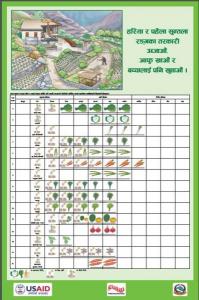Suaahara Homestead Food Production Seasonal Crop Calendars
Suaahara was a five year (2011-2016) project funded by USAID aimed to improve the nutritional status of women and children in 41 districts of Nepal. The project focused on improving health and nutrition behaviors at the household level through promotion of Essential Nutrition and Hygiene Actions (EN/HA), particularly Maternal, Infant and Young Child Nutrition (MIYCN), and addressing other determinants of under-nutrition, such as availability of and access to food, hygiene, quality of health care, child spacing and socio-cultural factors including gender and marginalization.
Suaahara was implemented by a consortium of partner organizations led by Save the Children.
The SBCC strategy established an internal quality materials review and production system to ensure that all partners in the consortium had mutually reinforcing, quality materials developed, pretested, produced and disseminated to the end user.
In the year 2013, Suaahara developed this Homestead Food Production (HFP) Seasonal Crop Calendars with communication input from SBCC team and technical input from thematic partner organization Helen Killer International, emphasizes the key message “diversify nutrient dense vegetables in your homestead garden throughout the year”. The main objective of developing this calendar was to increase vegetable diversity, to maximize vegetable production from same area/piece of land and to increase household’s access to diverse vegetables.
The Crop Calendars were developed according to agro-ecozones (Terai, Hill, High Hill and Mountain) and the Homestead Food Production Beneficiaries (HFPB) group leaders used these calendars during HFPB group meeting to re-emphasize group members about which crop should be planted when and which crop should be harvested when etc. etc. It was guiding materials for HFPB group embers to follow up the crop production cycle.
In the year 2014, these calendars were rebranded as guided by “Bhanchhin Aama” campaign and disseminated in all public places in Suaahara implementing districts through local NGO partners throughout the project period.
Source: Johns Hopkins Bloomberg School of Public Health/ Center for Communication Programs
Date of Publication: March 25, 2019
SIMILIAR RESOURCES
Tools
Examples
- Suaahara Training Guidelines and Participant Handbooks
- Suaahara Health Facility Operation and Management Committee Capacity Building Training and Operation Guidelines
- GESI Toolkit
- Maternal Newborn Child Health - Nutrition Quality Improvement Tools
- The Infection Control Symbol Package
- Community Communication MNCH e-Manual: Participatory Health Promotion Sessions
- Promoting Quality Malaria Medicine through Social and Behavior Change Communication
- The Future of Malaria Social and Behavior Change Communication
- SBCC for Malaria in Pregnancy: Strategy Development Guidance
- Malaria Case Management: Monitoring and Evaluation for SBCC

